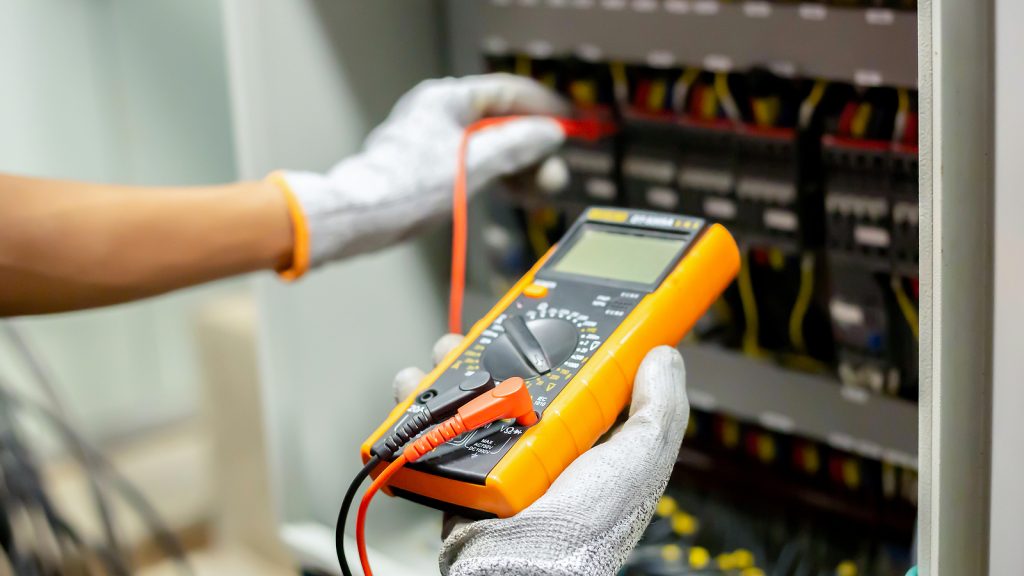Do you have a dead outlet? Don't call an electrician just yet! You can test it yourself with a multimeter. The multimeter is the basic tool for diagnosing electrical problems. It can let you troubleshoot outlet problems.

But if you feel you can't handle this yourself, contact Titan Plumbing And Electric. We provide 24/7 emergency electrical services to get your power back on quickly!
If you're not familiar with using a multimeter, don't worry. We'll walk you through the process step-by-step. With this guide, you'll be able to quickly test whether your outlet is working properly – and if it's not, you'll know exactly what needs to be fixed.
What Can You Learn From a Multimeter?
A multimeter is an essential tool for any homeowner or renter. It can help you troubleshoot all sorts of electrical problems.
With a multimeter, you can:
- Test whether an outlet is working
- Diagnose a tripped circuit breaker
- Find out whether an outlet is well grounded
How to Test an Outlet With a Multimeter in Simple Steps
- Know The Outlet Testing Safety Tips
You are going to perform these tests on live outlets. As a result, you should stay safe by holding the meter probes with one hand. This should prevent shock from going through your body. Don't let the metal portion of the probes touch each other. This can cause a short circuit, which isn't safe.
- Know The Outlet Geography
Your outlet, like other modern outlets, has three prongs. One is for hot, another for neutral, and the third for ground. The large, rounded half circle is the ground. The two vertical ones on either side are the hot and neutral wires that deliver electricity to your outlet. The longer slot on the left is neutral while the shorter slot on the right is hot. Since any of the three wires can hold current, you should be careful while handling them.
- Adjust The Multimeter
Now, adjust your multimeter to measure voltage. Choose the alternating current (AC) function on your multimeter. This should have the picture of a wavy line. This should be distinct from the direct current (DC) function which has a solid and a dashed line.
- Connect The Leads
Before you touch the exposed wires, make sure that the multimeter probes are not touching each other. If they are, it will create a short circuit. Now, connect the short, thick connector (banana plug) of the black lead into the COM connector (often with a minus sign). Next, plug in the red lead (often with a plus or horseshoe sign).
- Measure The Voltage so You Can Tell if Your Outlet Has Power
With one hand only, push a probe into each of the outlet's vertical slots. The red should go into the shorter of the two slots while the black goes into the larger slot. You should see a reading on your multimeter. If your outlet is in good condition, you will see a reading of 110 to 120 volts. A complete absence of reading means the outlet doesn't have power or your circuit breaker is tripped.
- Find out if Your Outlet is Well Grounded
Leave the red lead in the shorter slot and then move the black lead into the ground outlet slot. You should see the same reading as you did at the last step. If you don't, it means that the outlet isn't grounded or the ground wire is loose.
- Check For Reversed Wiring
To check if the wiring is reversed, place the red lead into the longer slot and the black lead into the shorter slot. Do you see a reading? If you do, it means the wiring is reversed. This isn't dangerous but it can cause your outlet to work less efficiently. Lamps and other simple equipment may work normally but electronics and other advanced appliances may be adversely affected.
- Check For Problems With an Appliance
To test an appliance, first, unplug it from the outlet. Then set your multimeter to the ohms function. It should have the Omega symbol or a picture of a horseshoe with a dashed line in the middle. Now, touch one lead to each of the appliance's prongs. You should see a reading of 2 ohms or a little less. This means the appliance is in good working order. If you see a reading of less than 2 ohms, it means there is a break in the circuit and the appliance needs to be repaired or replaced.
There you have it! Now you know how to use a multimeter to test an outlet. Remember to always exercise caution when working with electricity. If you're ever in doubt, don't hesitate to call a professional electrician.
If you don't feel comfortable testing your outlet on your own, or if you need help fixing it, please contact us at Titan Plumbing And Electric. We're always happy to help!
Get Help From Titan Plumbing And Electric
Don't let electrical problems stress you out. The professionals at Titan Plumbing And Electric are here to help. We have years of experience dealing with all sorts of electrical issues, so we know how to get the job done right. We're always available to answer your questions and give you a free estimate. Contact us today at (813) 680-2075!


